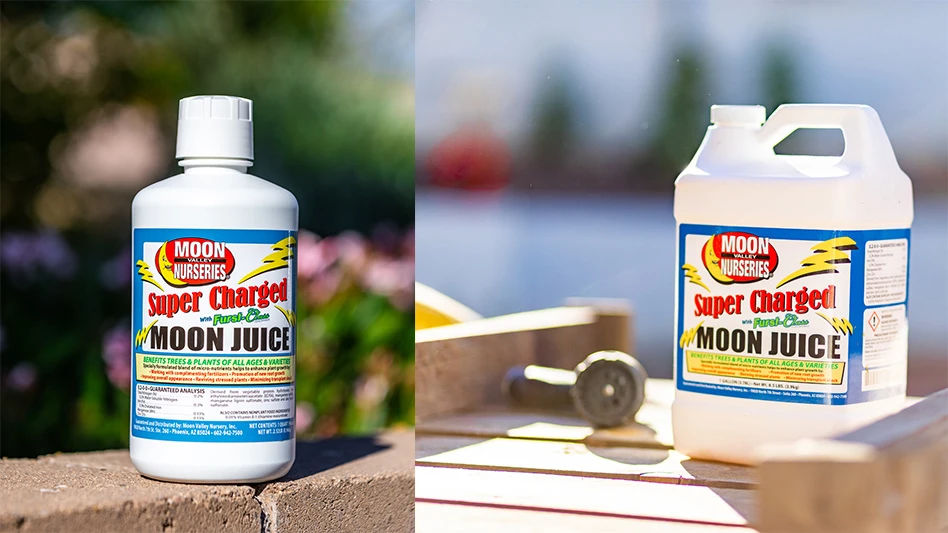
Plant propagation plays a vital role in the profitability of most commercial horticultural operations. While today’s comments are slanted toward traditional nursery operations specializing in woody plant species (trees, shrubs, etc.), most of the principles cross over to herbaceous plant species that bedding plant growers and perennial plant growers produce (Figure 1). In order of discussion this article will cover the stock or mother plant, cutting, rooting medium, propagation environment, and rooted cutting fertilization.

Fig. 1. English ivy is a cross over crop grown by woody crop growers, perennial crop growers, and bedding plant growers. Pictured is cutting production in 804 cell packs.
Stock or mother plant
Most growers subscribe to the adage that the quality of a crop is only as good as that of the cuttings or seedlings that are planted. Regarding plant propagation this rule reaches further up stream as the stock plants as well should be grown under strict conditions to present a healthy, pest free plant from which to harvest cuttings.
It is also common in horticulture crops for cuttings to be harvested not only from dedicated stock plants but also from plants being grown as a finished crop. This practice tends to be used on crop species with low susceptibility to high-threat pest infestations and is frowned upon for crops needing vigilant protection against viral, bacterial, and certain fungal pathogens. Regardless, clean growing practices that encourage healthy, pest free plants from which to harvest cuttings is a pre-requisite.
Pests include plant pathogens in three main categories; fungi, bacteria, and viruses. Pests also include insects and physiological disorders. Cuttings infested with insects or infected with any of the pathogens cited naturally insert these pest issues into the propagation cycle making control exponentially more challenging.
Physiological disorders can be nutritional, environmental, or crop culture based. For example, if a stock plant is experiencing a nutritional deficiency or toxicity either can create enough stress to negatively effect rooting and subsequent growth and development of cuttings harvested from it.

Cutting
Basic rules of plant propagation apply similarly across a wide range of horticultural crops requiring asexual propagation. Whether terminal stem cuttings are being used to propagate a poinsettia or geranium, immature wood cuttings for an ornamental tree or shrub, or root divisions for a herbaceous perennial, growers committed to clean, sound propagation practices are likely to experience higher yields and quality of rooted cuttings.
Start with healthy, clean asexual propagules whether they are stem cuttings, leaf cuttings, grafts, or root divisions. Stem cuttings will be referenced in the remainder of this discussion for brevity. Complementing asexual cutting propagation is sexual propagation involving flower pollination, seed production, seed sowing, and germination. Good propagation practices are nearly identical for asexual (cutting) and sexual (seed) propagation alike.
Cutting uniformity is a requirement that ripples through the entire propagation cycle and subsequent production cycle. Start by harvesting and sticking uniform terminal stem cuttings if terminal cuttings are preferred. Occasionally, cutting numbers may fall short of what’s scheduled to be stuck. In order to harvest and stick enough cuttings it might be necessary to harvest some sub-terminal cuttings. When this practice becomes necessary additional effort is required.
Isolate sub-terminal cuttings in separate plug trays because they likely will require more time to root given their older age and maturity. Having terminal and sub-terminal cuttings in a single plug tray may result in removal of the tray from mist earlier or later than desired as one of the two cutting types will influence the decision process. Also, subsequent growth and development of the young plants can be quite different. A terminal cutting begins growth as an un-pinched plant whereas a sub-terminal cutting, by definition, has already been pinched. Growing these plants side by side may create challenges in maintaining crop uniformity.
Rooting medium
Growers often find this area of propagation to be unnecessarily challenging. There are many growing mixes on the market which can be confusing. The primary characteristics of a quality propagation medium is that it be balanced regarding drainage and water holding capacity. Secondary inputs include nutritional amendments, growth promoting compounds (hormones, microbial products), pest control inputs (fungicide, beneficial microbes), and others.
Propagation environment
The basic factors affecting plant growth in general also play a role in propagation; temperature, water, light, and nutrition. The first two factors, temperature and water, play a primary role during the rooting phase of a cutting. Light and nutrition can be considered secondary, to a degree, until roots have initiated.
Both temperature and water are needed in higher amounts during propagation than during finished crop production. The rooting of cuttings usually requires a warmer temperature than the growth of the finished crop. Generally, the temperature of the rooting medium should be in the low seventy degree F range with 68-74 degrees being an acceptable target. Air temperature, particularly night temperature, does not have to be as high which meshes nicely with a bottom heat system of delivery.
Heat delivered to the root zone from below the plug tray is transferred to the plug tray and root medium. Some heat continues to be transferred from the plug tray and root medium to the air above the cuttings, keeping them warm but not as warm as the medium which is ideal. If the air temperature around the cuttings is too high stress can be created; before the cuttings root they may lose water faster than it can be replaced.
Water has two dimensions in a propagation discussion, root medium moisture content and relative humidity of the air. It is common to apply intermittent mist during cutting propagation to maintain relative humidity in the micro climate surrounding the cuttings. This moist air helps the cutting avoid desiccation via its leaves, petioles, and stems. Misting of cuttings usually applies enough water in the form of a fine mist to settle on the surface of the root medium and percolate through the root zone profile, thereby maintaining moisture throughout the root cube (Figure 2).

Fig. 2. Propagation greenhouse showing mist system and bottom heat (black tubing on bench surface)
Once cuttings form roots they are weaned off of mist to reduce disease incidence (Figure 3). Simultaneously, traditional irrigation commences to deliver water to the rooted cutting as it’s needed. Hand watering, boom watering, overhead sprinklers, and flood and drain benches are common irrigation systems in propagation areas. At this time, rooted cuttings are usually moved from the warm, moist propagation environment to a hardening off area where root development continues and the young plant’s shoot resumes active growth.

Fig. 3. Foliar pathogen causing death of one cutting that will likely spread to surrounding cuttings.
Light and fertilizer are not needed in high amounts during rooting. Shade is often used during high light periods and supplemental light is sometimes used during low light periods. Supplemental light may not be required during the early stage of rooting but has been shown to be beneficial once the rooted cuttings resume active shoot growth. An exception is photoperiod control where certain species may require day length manipulation. This area of light management is separate from photosynthetic light management.
Sanitation
Sanitation is a critical consideration in a propagation environment and deserving of its own discussion in a future article. Good sanitation practices correlate directly to successful propagation outcomes. Clean practices have been cited repeatedly in this article. Two of the pest categories presented above, plant pathogens and insects, can destroy crops during propagation. Comprehensive sanitation procedures go a long way in eliminating both pests.
General sanitation includes keeping hard surfaces in and around the propagation area clean and free of microbial contaminants. The list of microbes that cause problems is long and includes the plant pathogen categories cited above; fungal, viral, and bacterial pathogens. Associated with plant diseases as well are non-plant pathogenic microbes that indirectly interfere with a horticultural environment at any level.
Algae is at or near the top of the list of microbial contaminants that can disrupt a propagation setting (Figure 4). Biofilms are also on this list and are known to associate with algae in a symbiotic way that allows both to flourish in the presence of the other. Biofilm is ever-present in irrigation lines and when teamed with algae in the irrigation stream can result in line clogging as layered and resistant accumulations that are difficult to remove. Additionally, biofilm-algae complexes provide safe haven for plant pathogens such as Pythium and human pathogens such as E. coli.

Fig. 4. Algae development on plug tray surface causing crop loss.
Algae is at or near the top of the list of microbial contaminants that can disrupt a propagation setting. Biofilms are also on this list and are known to associate with algae in a symbiotic way that allow both to flourish in each others presence. Biofilm is ever-present in irrigation lines and when teamed with algae in the irrigation stream can result in line clogging, layered, and resistant accumulations that are difficult to remove. Additionally, biofilm-algae complexes provide safe haven for some plant pathogens such as Pythium.
Sanitation options such as chlorine, ozone, quaternary ammonium, UV light, and others will be discussed in a future article in this series.

Fig. 5. Don’t fire up those fertilizer injectors until cuttings root and resume active growth.
Fertilizer
Until a cutting forms roots there is little need for applying fertilizer during propagation. Doing so can have the opposite effect as fertilizer salts in the root medium could damage the fresh wound at the base of the cutting. Once a cutting roots and the shoot resumes active growth fertilization can commence (Figure 5).
Depending on crop species the resumption of fertilization often begins at a lower than final rate and gradually increases. Young rooted cuttings coming out of a warm propagation area may not be ready for full fertilization until they are acclimated (hardened off). The practice of hardening cuttings, also known as toning, will be discussed in a later article.
About the author: Peter Konjoian grew up on a family vegetable farm and greenhouse operation in Andover, Massachusetts, a northern suburb of Boston. He earned his B.S. degree at the University of New Hampshire and graduate degrees at the Ohio State University, Ph.D. in 1982. He then joined the horticulture faculty at the University of Maryland.
In 1984 he left the academic world to return to his family’s greenhouse operation in part so that he and his wife could raise their two children in an agricultural environment. In 1992 Dr. Konjoian started his private sector research and consulting business Konjoian’s Floriculture Education Services. In 2011 a name change from Floriculture to Horticulture was made to reflect his expanded research into hydroponic food crop production. He has spoken at grower conferences throughout the U.S. and Canada with over 600 presentations and writes frequently in grower trade magazines.
Dr. Konjoian can be reached at peterkfes@comcast.net.
All photos courtesy Peter Konojoian
Get curated news on YOUR industry.
Enter your email to receive our newsletters.Latest from Nursery Management
- Society of American Florists accepting entries for 2025 Marketer of the Year Contest
- Sustainabloom launches Wholesale Nickel Program to support floriculture sustainability
- American Horticultural Society welcomes five new board members
- Get to know Christopher Brown Jr. of Lancaster Farms
- American Floral Endowment establishes Demaree Family Floriculture Advancement Fund
- The Growth Industry Episode 3: Across the Pond with Neville Stein
- The Growth Industry Episode 2: Emily Showalter on how Willoway Nurseries transformed its business
- March 2025 issue recap





